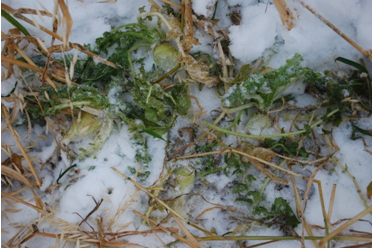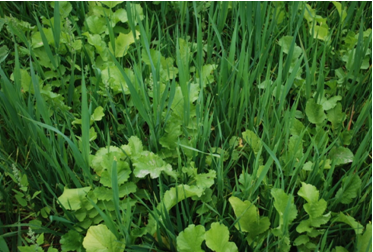Cover crop grazing with sheep: lessons learned from recent MSU extension demonstration event
The grazing demonstration provides a good example of a win-win situation for cooperating farmers and the environment.
Producer interest in cover crop grazing was high as attested by attendance of over 50 producers at a program that landed on a beautiful November afternoon hosted by Michigan State University (MSU) Extension small ruminant specialist Richard Ehrhardt. Producers discovered that cover crop grazing:
- Provides high quality forage during an otherwise dormant growing season
- Provides inexpensive forage with or without supplemental fertilization
- Is feasible using portable, electric net fencing on neighboring crop ground.
Cover crop combinations and rationale
Mixtures of cover crops were evaluated for yield and quality during the late fall/early winter growing season. Mixtures of oats (48 pounds per acre) combined with brassicas (oilseed radish and or turnips; total of 5 lbs per acre) were seeding using a no-till drill after wheat harvest in early August. The rationale for these choosing these particular combinations were to optimize:
- Growth during cool weather
- Erosion control following grazing until spring planting
- Nutrient profile to the animal (high digestibility yet with adequate fiber content)
- Nutrient scavenging from throughout the soil profile
- Maintenance of forage quality into winter
- Germination under limited soil moisture conditions
Crop and livestock farmer partnership
This venture was a partnership between a grain and livestock (sheep) farmer. The sheep farmer provided the seed and fertilizer while the crop farmer did the seeding and provided the opportunity to use his land following wheat harvest. Perceived benefits to the crop farmer were improvements in retention of soil nutrients and soil drainage to increase future crop yields. Potential benefits to the sheep farmer were inexpensive, parasite-free quality forage and ability to rest pastures on their farm. Grazing began after growth ceased ant he plants were no longer taking up nutrients from the soil. Animals were contained by portable electric netting fence at a stocking rate of 24 adult ewes per acre.
Cover Crop yields
Germination of the cover crop mixes was not optimal due to unseasonably wet field conditions. So, the yields observed should be viewed as a low estimate of what could be expected under more ideal conditions.
| 82 day yield (lbs per acre) | ||||
| No seed | Turnips and Oats | Radishes and Oats | Turnips, Radishes and Oats | |
| No fertilizer | 397 | 1256 | 1472 | 1482 |
| 46 lbs N | 602 | 2706 | 2533 | 295 |
Without fertilizer, radish and radish -turnip mixtures had similar yields which were superior to turnips alone. When N fertilizer was applied at seeding, turnips displayed a greater relative response than radishes. This suggests that the radish mixtures may be more ideal for seeding into low fertility soils whereas turnip/radish mixtures may more appropriate for higher fertility soils and preferred when fertilizer is applied.
Forage production costs
The forage production costs shown below include seed and fertilizer costs. They do not include tillage and seeding costs that were covered by the crop farmer in this particular cooperative arrangement. If planting costs were included, the additional yields observed with fertilizer treatment would have been much more cost effective as this fixed cost would have been diluted over the greater forage yield. The cost of the additional response to fertilizer (on a per ton basis) was $42 for the three-way mixture, $43 for the turnip-oat mixture and $57 for the radish-oat mixture. Compared to purchased forages of comparable quality (>$100/ton) this forage was very inexpensive. These results indicate that even in poor germination situations, the value of the forage produced offset production costs and that additional fertilizer inputs were cost effective.
| Cost per ton of forage ($) | ||||
| No seed | Turnips and Oats | Radishes and Oats | Turnips, Radishes and Oats | |
| No fertilizer | 0 | 32 | 32.5 | 29.7 |
| 46 lbs N | 102 | 37.7 | 42.8 | 35.6 |
Nutritional value of cover crops
The nutritional value of the cover crops was high and above the requirements of the ewes grazing the fields and as a result the ewe flock improved weight and body condition. The energy content of the diet was particularly high due to the high digestibility of the diet. The digestibility of brassica component is known to be extremely high with low fiber content. The addition of oats in the mixture added fiber to the diet providing a complimentary nutrient to offset potential digestive disturbances if brassicas alone were grazed. In addition, the oat stubble left behind following grazing likely provided helpful erosion control.
| No seed | Turnips and Oats | Radishes and Oats | Turnips, Radishes and Oats | |
| Crude Protein (%) | 21 | 12 | 12 | 12 |
| ADF 1(%) | 23 | 24 | 25 | 24 |
| NDF2(%) | 43 | 38 | 38 | 36 |
| TDN3(%) | 77 | 75 | 75 | 76 |
| 48 h dry matterdigestibility | 93 | 90 | 90 | 91 |
1 ADF=acid detergent fiber
2NDF=neutral detergent fiber
3TDN=total digestible nutrients
Summary
The grazing demonstration provides a good example of a win-win situation for co-operating farmers and the environment.
| Benefits of cover crop grazing: | |
| Livestock farmer: | Crop farmer: |
| Inexpensive, quality forage | Retention of soil nutrients |
| Parasite-free grazing | Erosion control |
| Resting of permanent pastures | Enhanced residue recycling |
| Extended grazing into winter | Weed control |

Healthy ewes grazing cover crop mixtures through the snow.

Forage radishes and oat mixture as uncovered by sheep grazing through the snow in mid December.

Forage radish and oat mixture in late September after 50 days of growth.



 Print
Print Email
Email




